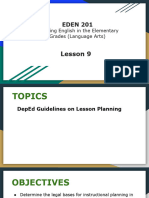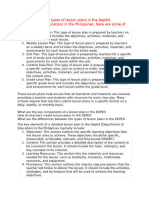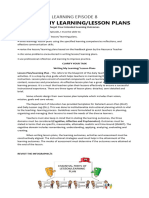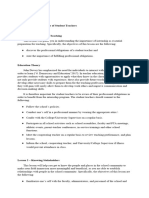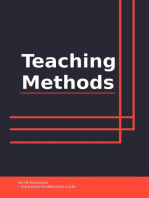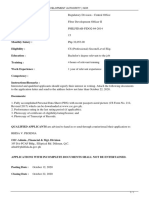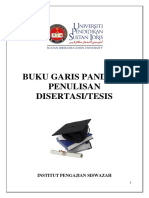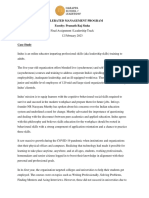Lesson Plan
Lesson Plan
Uploaded by
clementineeleaunoireCopyright:
Available Formats
Lesson Plan
Lesson Plan
Uploaded by
clementineeleaunoireOriginal Title
Copyright
Available Formats
Share this document
Did you find this document useful?
Is this content inappropriate?
Copyright:
Available Formats
Lesson Plan
Lesson Plan
Uploaded by
clementineeleaunoireCopyright:
Available Formats
LESSON 9:DepEd Guidelines on Lesson Planning
Objectives
In this lesson, you will be able to:
● Determine the legal bases for instructional planning in the Department of Education;
● Identify key features of instructional planning: and
● Explain how the instructional planning strategies could be integrated in with the DepEd
Guidelines.
The Enhanced Basic Education Act of 2013 has transformed the education sector from a
competency-based to a standards-based approach, with the K to 12 curriculum emphasizing
performance and outputs over simple tests. This change necessitates a shift in instructional
planning. The Department of Education has released guidelines to ensure that planning is done
in an orderly and regular manner. Instructional planning is fundamental to ensuring the delivery
of teaching and learning in schools, involving three major steps: planning instruction, delivery of
instruction, and assessment of learning. This process requires teachers to be prepared to
organize, develop, and evaluate the plan.
Key features of the K to 12 Curriculum include the spiral progression of content constructivist
views on learning and meaning-making, and the use of differentiated instructions. Therefore,
instructional planning should reflect these features in the lessons teachers plan for. The DepEd
Order No. 42, s. 2016, provides guidelines on daily lesson preparation for the K to 12 Education
Program.
Elements of the Learning Plan
The lesson plan serves as the teacher's map in attaining the objectives of the lesson.
the lesson plan should answer the following questions:
What should be taught?
In planning for daily lessons, the teacher needs to follow the curriculum guide of the target
learning area. As such, a deep understanding of the curriculum is required from the teacher in
order to teach the content. Key areas to be taught from the curriculum guide are:
● Content Standards
● Essential Knowledge/Understanding
● Performance Standards
● Learning Competencies
How should it be taught?
The DepEd policy also acknowledges that with the use of the lesson plan, the teacher can
identify which parts of the lesson the learners could find difficult and address them appropriately.
Furthermore, teachers are expected to utilize varied strategies. Teachers are encouraged to use
strategies that address the learners' cognitive abilities, learning styles, readiness levels, multiple
intelligences, gender, socio-economic background, culture, ethnicity, physical ability, and special
needs just to name a few.
These strategies could include:
● Direct instruction, where a material is taught in a sequential manner. This strategy is
usually used in teaching facts, rules, or action sequences.
● Indirect instruction is a strategy that directly involves the learners as a more active
participant in the classroom rather than a passive one
● Interactive instruction uses active leaming methods to engage the learners to interact
with each other and their teacher.
● Experiential instruction involves the learners in the learning experience. They become
part of the learning process rather than simply a recipient of learning, thus the teacher
puts more emphasis on the process rather than the product.
● Independent study, as the name suggests, the teacher's control of the learning
experience is reduced, and gives the learners the reign on their interaction with the
content.
How should learning be assessed?
Lesson planning not only involves planning for the execution of the lesson, it should also convey
an assessment plan in measuring student learning. The policy refers to DepEd Order No. 8, s.
2015 entitled Policy Guidelines on Classroom Assessment for the K to 12 Basic Education
Program. The guidelines put a premium on the use of formative assessment as a tool to help
learners identify their strengths and weaknesses. It also helps the learners make adjustments to
their teaching as areas of concern are identified.
Learning Plans
DepEd Order 42, s. 2016 recognizes that teachers acquire more experience and competency as
they progress in the teaching profession. As such, it provides different plan templates for
different teachers. Newly hired teachers without professional teaching experience will be
required to prepare a daily Detailed Lesson Plan (DLP) for one year. On the other hand,
teachers with at least one year of teaching experience will be required to use the weekly Daily
Lesson Log (DLL).
Parts of a Detailed Lesson Plan (DLP)
Before the Lesson
This part describes the preliminary activities prior to the actual introduction of the lesson.
The Lesson Proper
The teacher presents the new material to the learners. He/she employs various strategies and
methods to convey the new concepts, skills, and competencies to the learners.
After the Lesson
This begins with a wrap-up activity where the teacher provides a summary of the lesson or asks
the learners to summarize the lesson for the class.
Parts of a Daily Lesson Log (DLL)
Objectives - They describe what the teacher intends to attain for the day.
● Content standards - are the facts, concepts, and procedures based on each of the
learning areas that the learners need to learn.
● Performance standards are the tasks that learners need to perform based on what they
understand about the content.
● Learning competencies are the knowledge, skills, and attitudes that learners need to
demonstrate in the duration of the lesson.
Content-This describes the subject matter of the lesson
Learning Resources - This pertains to the references and other sources of information the
teacher will use for the lesson.
Procedures For the Daily Lesson Log, procedure for delivering the lesson shall be composed of
10 steps:
● Reviewing of previous lesson or presentation of the lesson
● Establishing purpose for the lesson as a form of motivation
● Presentation of examples for content and competencies in order to clarify concepts
● Discussion of new concepts, leading to the first formative assessment activity prior to the
deepening of the lesson
● Development of the concept to deepen learners' understanding leading toward the
second formative assessment
● Deepen understanding of the learners on the lesson's concepts to lead toward mastery.
This is through implementation of group and collaborative activities.
● Helping learners find practical ways to use the knowledge and skills they have learned in
the lesson
● Making generalization and abstractions about the concepts and insights from the lesson
● Evaluation learning to assess whether the lesson objectives were met
● Providing additional activities for the application of the lessons learned or remediation for
learners who may have had difficulty with the lesson
Remarks-This part indicates the special cases, such as continuation of the lesson or reteaching
or rescheduling due to lack of time or suspension of classes.
Reflection-This is where the teacher reflects on what transpired during the lesson:
● How many learners got 80% in the evaluation?
● How many learners need additional activities?
● Did the remediation activities work?
● How many require additional work?
● Which strategies used in the lesson engaged the learners?
● What are the difficulties encountered by the teacher and learner before, during, and after
the lesson?
● Which of the practices that is used in this lesson could be shared with my colleagues?
You might also like
- Al Kitaab Answer KeyDocument17 pagesAl Kitaab Answer Keysarahmohammed801No ratings yet
- Role of Teacher in Curriculum DevelopmentDocument6 pagesRole of Teacher in Curriculum Developmentshahrukhzia71% (14)
- Megan Gregory Epsy715 ReflectionDocument2 pagesMegan Gregory Epsy715 Reflectionapi-271896767No ratings yet
- ReporterDocument3 pagesReporterayu126684No ratings yet
- Lesson 9 Deped Guidelines On Lesson PlanningDocument15 pagesLesson 9 Deped Guidelines On Lesson PlanningReynanNo ratings yet
- IP Teaching and Learning - Module OverviewDocument6 pagesIP Teaching and Learning - Module OverviewOnkgopotseNo ratings yet
- Lesson PlanningDocument32 pagesLesson Planningquinnia.rainiiNo ratings yet
- Deped Order 42 S 2016Document34 pagesDeped Order 42 S 2016Larry Espanola CasalNo ratings yet
- Teacher Education CurriculumDocument1 pageTeacher Education CurriculumtizonhanaNo ratings yet
- Deped Order 42 S 2016 FINDocument48 pagesDeped Order 42 S 2016 FINKim ArangoNo ratings yet
- Instructional Planning: Ms. Cherylou D. Bacalan, LPTDocument30 pagesInstructional Planning: Ms. Cherylou D. Bacalan, LPTIvy Versoza ManaNo ratings yet
- Development of Lesson PlanDocument10 pagesDevelopment of Lesson PlanGeosippi San Antonio LaymanNo ratings yet
- Lesson-13-Structuring-the-Lesson-PlanDocument13 pagesLesson-13-Structuring-the-Lesson-Plancren48984No ratings yet
- Instructional PlanningDocument6 pagesInstructional PlanningMarienel Ilagan100% (1)
- ST OrientationDocument84 pagesST Orientationanthonytungs8No ratings yet
- EDU 402Document4 pagesEDU 402MUQADDAS EJAZNo ratings yet
- TTTSC Finals ReviewerDocument29 pagesTTTSC Finals ReviewerJuju GarlanNo ratings yet
- Activities For LACDocument3 pagesActivities For LACJERICO IGNACIONo ratings yet
- Lesson Plans in The DepEdDocument6 pagesLesson Plans in The DepEdbetbetmanfalangNo ratings yet
- Lesson Planning in Education and Training CoursesDocument3 pagesLesson Planning in Education and Training CoursesHiền NguyễnNo ratings yet
- DepEd Guidelines On Lesson PlanningDocument39 pagesDepEd Guidelines On Lesson PlanningJune Lee CamarinNo ratings yet
- D.O 42. 2016Document34 pagesD.O 42. 2016Celeste BatallaNo ratings yet
- LDM2 Reflection Paper For MTs or HTs As LAC LEADERDocument8 pagesLDM2 Reflection Paper For MTs or HTs As LAC LEADERRonald Artillero95% (138)
- Handouts Sabalboro MC English 1Document2 pagesHandouts Sabalboro MC English 1helainapegNo ratings yet
- Lesson 8 Developing Lesson PlanDocument20 pagesLesson 8 Developing Lesson PlanTherese Carmel BarbasoNo ratings yet
- Lesson PlanningDocument31 pagesLesson PlanningAira Calvo100% (2)
- DLL-power - Point DO.42.s.2016Document46 pagesDLL-power - Point DO.42.s.2016Yumi RikiwiNo ratings yet
- Role of Teacher in Curriculum DevelopmentDocument6 pagesRole of Teacher in Curriculum DevelopmentNamratha BalajeeNo ratings yet
- Elements of CurriculumDocument27 pagesElements of CurriculumAli imtiazNo ratings yet
- PED-10 21st Century and New Literacies and Curriculum ProcessDocument26 pagesPED-10 21st Century and New Literacies and Curriculum ProcessBTLED-1202 Aggabao ErwinNo ratings yet
- Lesson 1 DepEd Guidelines On Instructional PlanningDocument9 pagesLesson 1 DepEd Guidelines On Instructional PlanningJeanmae Omalyao MakilingNo ratings yet
- Ped 9 Content Module 8 2Document15 pagesPed 9 Content Module 8 2Arline Hinampas BSED-2204FNo ratings yet
- Principles of PlanningDocument18 pagesPrinciples of Planningsanjanapinto23No ratings yet
- Official Guidelines For Assesment Under The New Normal: DEPED ORDER 31 S. 2020Document28 pagesOfficial Guidelines For Assesment Under The New Normal: DEPED ORDER 31 S. 2020jemilyn tungculNo ratings yet
- DO 8 S. 2016 Policy Guidelines On Classroom Assessment For The K To 12Document59 pagesDO 8 S. 2016 Policy Guidelines On Classroom Assessment For The K To 12Tristan Lindsey Kaamiño Ares92% (38)
- Mission and Vision PlanningDocument2 pagesMission and Vision Planningapi-530086963No ratings yet
- Lesson Planning For DepEd TeachersDocument8 pagesLesson Planning For DepEd Teachersyenihc009No ratings yet
- Daily Lesson Log PreparationDocument18 pagesDaily Lesson Log Preparationliza100% (3)
- Group 5 Educ 5Document9 pagesGroup 5 Educ 5joharasamaonrajak.09No ratings yet
- School Learning Action Cell Session: First Quarter-Kindergarten Slac Session 1Document7 pagesSchool Learning Action Cell Session: First Quarter-Kindergarten Slac Session 1Anthonette Calimpong Bermoy-BurgosNo ratings yet
- Curriculum D AnglaisDocument122 pagesCurriculum D AnglaisAmmar HelimiNo ratings yet
- Parts of A Daily Lesson Log (DLL)Document18 pagesParts of A Daily Lesson Log (DLL)Cabildo, Neil Andrei T.67% (3)
- Group 2 Key PointersDocument6 pagesGroup 2 Key PointersDarlene EsmeraldaNo ratings yet
- Instructional Process v2.1pdfDocument2 pagesInstructional Process v2.1pdfClaudio Melo VergaraNo ratings yet
- LEARNING-EPISODE-8-10Document16 pagesLEARNING-EPISODE-8-10Racel Matig-aldaoNo ratings yet
- Lesson Planning DEPED 42S 2016 2Document78 pagesLesson Planning DEPED 42S 2016 2Nilkie AtunNo ratings yet
- Lesson Planning Unit 1Document11 pagesLesson Planning Unit 1Kamran Abdullah100% (1)
- Puntos 4, 5 y 6Document4 pagesPuntos 4, 5 y 6Fátima LópezNo ratings yet
- PED-12 - Module5 031339Document11 pagesPED-12 - Module5 031339jepersoncarino59No ratings yet
- Daily Lesson LogDocument2 pagesDaily Lesson LogFloreann BascoNo ratings yet
- Unit II Lesson 2 SC-PEHDocument4 pagesUnit II Lesson 2 SC-PEHJewin OmarNo ratings yet
- LESSON 8 Developing Lesson Plans For Social StudiesDocument29 pagesLESSON 8 Developing Lesson Plans For Social StudiesAxel VirtudazoNo ratings yet
- Chapter Thirteen NotesDocument8 pagesChapter Thirteen Notesapi-649702984No ratings yet
- Chapter 8Document4 pagesChapter 8Ruvy Caroro Legara DenilaNo ratings yet
- PPT4 Basics of Instructional PlanningDocument23 pagesPPT4 Basics of Instructional PlanningJocelyn CalezaNo ratings yet
- Outcome Based Education: TerminologyDocument18 pagesOutcome Based Education: TerminologyHoney KaurNo ratings yet
- EBS 252G UNIT 5Document18 pagesEBS 252G UNIT 5silentcapriNo ratings yet
- Learning & Study Guide for Adult Students: Teacher's ManualFrom EverandLearning & Study Guide for Adult Students: Teacher's ManualNo ratings yet
- A Practical Roadmap to Organizing and Managing the Special Ed ClassroomFrom EverandA Practical Roadmap to Organizing and Managing the Special Ed ClassroomNo ratings yet
- How To Write A Review C2 Proficient (CPE)Document1 pageHow To Write A Review C2 Proficient (CPE)aleksandra.nikolova2007No ratings yet
- Brisk Teaching AiDocument8 pagesBrisk Teaching Aiapi-741385269No ratings yet
- CSC Job Portal: Philippine Fiber Industry Development Authority - NCRDocument1 pageCSC Job Portal: Philippine Fiber Industry Development Authority - NCRSherwin DannogNo ratings yet
- Integrated Communications Plan: The Agency Down UnderDocument42 pagesIntegrated Communications Plan: The Agency Down Underapi-302623055No ratings yet
- Expert IELTS 7 5 Expert Speaking Video TranscriptDocument6 pagesExpert IELTS 7 5 Expert Speaking Video Transcriptnika masNo ratings yet
- MWF EssayDocument1 pageMWF EssayKireet PanugantiNo ratings yet
- IBA Versus Lums: Submitted By: Zohaib AzharDocument10 pagesIBA Versus Lums: Submitted By: Zohaib Azharxubi_xNo ratings yet
- Kristen Rodick CVDocument4 pagesKristen Rodick CVapi-380761906No ratings yet
- Kata For ClassroomDocument38 pagesKata For ClassroomHarold GómezNo ratings yet
- Format ThesisDocument53 pagesFormat ThesisMohd Faizal100% (2)
- First Quarter Card Day 22 23Document4 pagesFirst Quarter Card Day 22 23sandra mae dulayNo ratings yet
- DR Seuss Lesson 3Document3 pagesDR Seuss Lesson 3api-317252968No ratings yet
- PMAEE Application Form 2020Document2 pagesPMAEE Application Form 2020x manNo ratings yet
- ROX-NLC Accomplishment ReportDocument4 pagesROX-NLC Accomplishment ReportHerbert BatarioNo ratings yet
- LP Redemo 2 1Document11 pagesLP Redemo 2 1Randy Asilum AlipaoNo ratings yet
- TeacherpreneurtraitsDocument3 pagesTeacherpreneurtraitsapi-281486234No ratings yet
- Geodesign With Little Time and Small DataDocument13 pagesGeodesign With Little Time and Small DataqpramukantoNo ratings yet
- Uksee 2018 BrochureDocument51 pagesUksee 2018 BrochureNikhil PahariaNo ratings yet
- PLC Jan April 2024 LLB Exam TimetableDocument1 pagePLC Jan April 2024 LLB Exam Timetablewanjiruirene3854No ratings yet
- Human Resource Management 611 (Bookmarked)Document83 pagesHuman Resource Management 611 (Bookmarked)Jishu Twaddler D'CruxNo ratings yet
- CurriculumDocument17 pagesCurriculumAlondra SiggayoNo ratings yet
- Leadership Track Final Assignment AMPC1 HSoLDocument6 pagesLeadership Track Final Assignment AMPC1 HSoLShubhanshi SinghNo ratings yet
- Open Educational ResourcesDocument8 pagesOpen Educational Resourcesjessica.cusackNo ratings yet
- The Evolution of Management ThoughtDocument7 pagesThe Evolution of Management ThoughtAashvin KishoreNo ratings yet
- Definition of Functional Varieties of LanguageDocument2 pagesDefinition of Functional Varieties of Languageanita basrah67% (3)
- Skill Theme Approach LessonDocument7 pagesSkill Theme Approach Lessonapi-273451087No ratings yet
- The Impact of Armed Banditry and Kidnapping On Socio-Economic Activities: Case Study of Selected Local Government Areas in Katsina State, NigeriaDocument16 pagesThe Impact of Armed Banditry and Kidnapping On Socio-Economic Activities: Case Study of Selected Local Government Areas in Katsina State, Nigeriaalmustapha muhammadNo ratings yet
- SON, JANN EDSON - 1BSN-A10 - SESSION#14-15-16 (SAS Monitoring and Mentoring SY 22-23 Yr1)Document3 pagesSON, JANN EDSON - 1BSN-A10 - SESSION#14-15-16 (SAS Monitoring and Mentoring SY 22-23 Yr1)Jann Edson SonNo ratings yet




